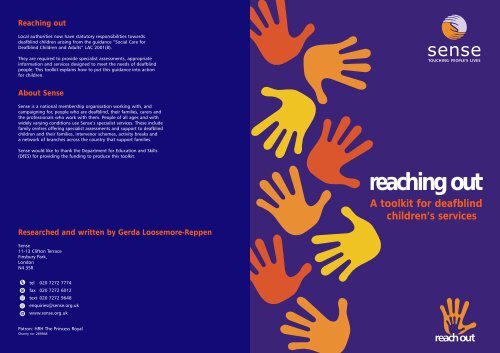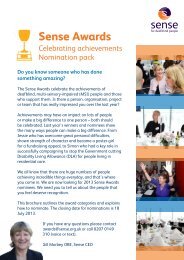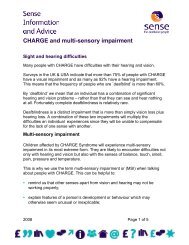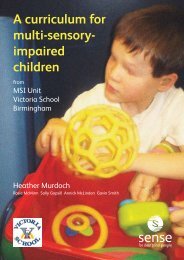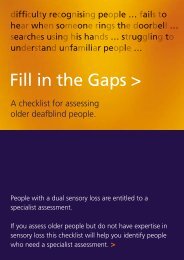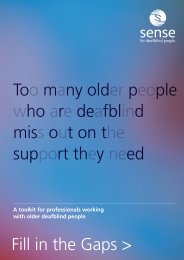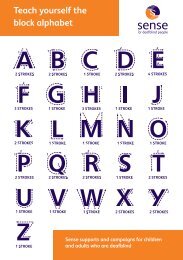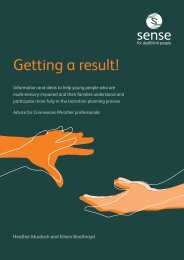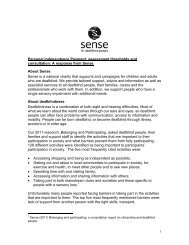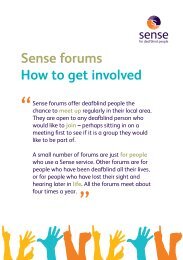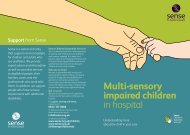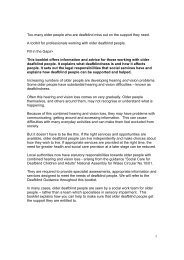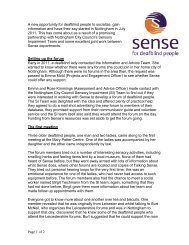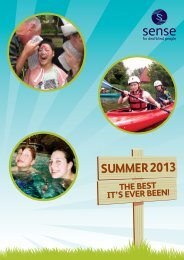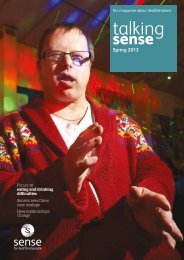A toolkit for deafblind children's services reaching out ... - Sense
A toolkit for deafblind children's services reaching out ... - Sense
A toolkit for deafblind children's services reaching out ... - Sense
Create successful ePaper yourself
Turn your PDF publications into a flip-book with our unique Google optimized e-Paper software.
Reaching <strong>out</strong><br />
Local authorities now have statutory responsibilities towards<br />
<strong>deafblind</strong> children arising from the guidance “Social Care <strong>for</strong><br />
Deafblind Children and Adults” LAC 2001(8).<br />
They are required to provide specialist assessments, appropriate<br />
in<strong>for</strong>mation and <strong>services</strong> designed to meet the needs of <strong>deafblind</strong><br />
people. This <strong>toolkit</strong> explains how to put this guidance into action<br />
<strong>for</strong> children.<br />
Ab<strong>out</strong> <strong>Sense</strong><br />
<strong>Sense</strong> is a national membership organisation working with, and<br />
campaigning <strong>for</strong>, people who are <strong>deafblind</strong>, their families, carers and<br />
the professionals who work with them. People of all ages and with<br />
widely varying conditions use <strong>Sense</strong>’s specialist <strong>services</strong>. These include<br />
family centres offering specialist assessments and support to <strong>deafblind</strong><br />
children and their families, intervenor schemes, activity breaks and<br />
a network of branches across the country that support families.<br />
<strong>Sense</strong> would like to thank the Department <strong>for</strong> Education and Skills<br />
(DfES) <strong>for</strong> providing the funding to produce this <strong>toolkit</strong>.<br />
<strong>reaching</strong> <strong>out</strong><br />
A <strong>toolkit</strong> <strong>for</strong> <strong>deafblind</strong><br />
children’s <strong>services</strong><br />
Researched and written by Gerda Loosemore-Reppen<br />
<strong>Sense</strong><br />
11-13 Clifton Terrace<br />
Finsbury Park,<br />
London<br />
N4 3SR<br />
tel 020 7272 7774<br />
fax 020 7272 6012<br />
text 020 7272 9648<br />
enquiries@sense.org.uk<br />
www.sense.org.uk<br />
Patron: HRH The Princess Royal<br />
Charity no: 289868
Many <strong>deafblind</strong> children and young people<br />
are living lives that are much more restricted<br />
than they need be. They’re missing <strong>out</strong><br />
on opportunities to learn ab<strong>out</strong> the world<br />
around them, to grow in confidence and<br />
to join in the life of the community. The<br />
very nature of <strong>deafblind</strong>ness is isolating,<br />
but these children are even more isolated<br />
from the world they live in because so much<br />
of it is inaccessible to them. But it doesn’t<br />
have to be like this. If the right <strong>services</strong> and<br />
opportunities are available then their life<br />
experience can be greatly enhanced.<br />
Local authorities now have statutory<br />
responsibilities towards <strong>deafblind</strong> children<br />
arising from the guidance “Social Care <strong>for</strong><br />
Deafblind Children and Adults” LAC 2001(8).<br />
They are required to provide specialist<br />
assessments, appropriate in<strong>for</strong>mation and<br />
<strong>services</strong> designed to meet the needs of<br />
<strong>deafblind</strong> people. This <strong>toolkit</strong> explains how<br />
to put this guidance into action <strong>for</strong> children.<br />
Contents<br />
The <strong>deafblind</strong> guidance <strong>for</strong> children 4<br />
What does it say?<br />
Who is it <strong>for</strong>?<br />
What is <strong>deafblind</strong>ness? 7<br />
How should the guidance be implemented?<br />
Identifying and assessing <strong>deafblind</strong> children 10<br />
Surveys to identify <strong>deafblind</strong> children<br />
How should the assessment be carried <strong>out</strong>?<br />
Services 17<br />
Importance of one-to-one support<br />
Intervenors<br />
Communicator guides<br />
Other support<br />
Support <strong>for</strong> families<br />
Short breaks and holidays<br />
Home help<br />
Direct payments<br />
Co-ordination 21<br />
Key workers<br />
Early support family service planning<br />
Transition arrangements<br />
Accessible in<strong>for</strong>mation<br />
Resources 26<br />
Self-assessment checklist<br />
References<br />
Useful organisations<br />
2 3
The <strong>deafblind</strong> guidance <strong>for</strong> children<br />
1<br />
This <strong>toolkit</strong> has been produced to highlight children’s <strong>services</strong><br />
statutory responsibilities arising from the guidance “Social Care <strong>for</strong><br />
Deafblind Children and Adults” LAC 2001(8).<br />
In 2002 and 2003 <strong>Sense</strong> carried <strong>out</strong> surveys of how local authorities<br />
were implementing the new provisions. It found that local<br />
authorities had not grasped the implications <strong>for</strong> children clearly<br />
enough – often because lead responsibility <strong>for</strong> <strong>deafblind</strong> people was<br />
allocated to a senior manager in the adults division, usually someone<br />
in charge of <strong>services</strong> <strong>for</strong> disabled people. This <strong>toolkit</strong> explains the<br />
implications <strong>for</strong> children’s <strong>services</strong> and provides practical advice on<br />
what steps can be taken to implement the guidance.<br />
This <strong>toolkit</strong> explains the importance of social care <strong>services</strong> to<br />
the well-being of <strong>deafblind</strong> children and their families and to<br />
their social needs <strong>out</strong>side school.<br />
In the future, many <strong>services</strong> will be provided by Children’s Trusts<br />
or joint Children’s Departments composed from Local Education<br />
Authorities and Children’s Social Services departments, sometimes<br />
additionally through a joint agency arrangement with the Primary<br />
Care Trust. This <strong>toolkit</strong> is timely and will coincide with the National<br />
Service Framework <strong>for</strong> Children, Young People and Maternity<br />
Services. The responsibilities of teachers and others in regard to<br />
children with special educational needs (SEN) are laid down in<br />
primary legislation (SENDA, 2001) and the accompanying Code of<br />
Practice on the Identification and Assessment of Pupils with Special<br />
Educational Needs (2001). These relate to learning and access to<br />
<strong>for</strong>mal education.<br />
Given the slow and limited implementation of the guidance in<br />
children’s <strong>services</strong> and the low incidence of <strong>deafblind</strong>ness in children<br />
across the country, there are few examples of positive practice.<br />
However, some authorities have interpreted the guidance creatively<br />
and developed <strong>services</strong> which meet the needs of children and their<br />
families. These examples are described.<br />
This material focuses on the role of managers in children’s <strong>services</strong> in<br />
councils with social <strong>services</strong> responsibilities, but it may also be of<br />
value to health visitors, paediatric staff, support teachers and early<br />
years service providers working in partnership with social workers.<br />
Some resources <strong>for</strong> further reference are also appended.<br />
What does the guidance say?<br />
The guidance provides a statutory framework <strong>for</strong> all social <strong>services</strong><br />
<strong>for</strong> <strong>deafblind</strong> people. It <strong>out</strong>lines the rights of <strong>deafblind</strong> people and<br />
the duties placed on local authorities.<br />
Local authorities must<br />
● identify, make contact with, and keep a record of <strong>deafblind</strong><br />
people in their catchment area – including those who have<br />
multiple disabilities that include dual sensory impairment;<br />
In addition local authorities must ensure that:<br />
● an assessment is carried <strong>out</strong> by a specifically trained person/team,<br />
equipped to assess the needs of a <strong>deafblind</strong> person – in particular<br />
to assess the need <strong>for</strong> one-to-one human support, assistive<br />
technology and rehabilitation;<br />
● appropriate <strong>services</strong> are provided to <strong>deafblind</strong> people, who are<br />
not necessarily able to benefit from mainstream <strong>services</strong> or those<br />
<strong>services</strong> aimed primarily at blind people or deaf people who are<br />
able to rely on their other senses;<br />
● specifically trained, one-to-one support workers are available <strong>for</strong><br />
those assessed as requiring one;<br />
● in<strong>for</strong>mation ab<strong>out</strong> <strong>services</strong> is provided in <strong>for</strong>mats and using<br />
methods that are accessible to <strong>deafblind</strong> people;<br />
● one member of senior management includes in his responsibilities<br />
overall responsibility <strong>for</strong> <strong>deafblind</strong> <strong>services</strong>.<br />
The guidance and its duties are mandatory. Failure to<br />
comply could result in a challenge through judicial review.<br />
4 5
What is <strong>deafblind</strong>ness?<br />
Who is the guidance <strong>for</strong>?<br />
This is statutory guidance <strong>for</strong> councils with social <strong>services</strong><br />
responsibilities (CSSRs). With structural changes occurring locally<br />
and nationally in the context of the Children Bill and the creation<br />
of Children’s Trusts responsibility <strong>for</strong> the implementation of the<br />
guidance will be firmly located within the remit of the new post<br />
of Director of Children’s Services.<br />
2<br />
The implementation of the guidance requires partnership between<br />
all agencies and professionals working <strong>for</strong> and on behalf of <strong>deafblind</strong><br />
children. Clear accountability and effective communication between<br />
the partners will assist a successful implementation process.<br />
The Commission <strong>for</strong> Social Care Inspection (CSCI) will be<br />
reviewing compliance with the guidance as part of its<br />
regular inspection function.<br />
How does your authority measure up?<br />
● Allocation of lead responsibility <strong>for</strong> <strong>deafblind</strong> children at appropriate senior level. ■ ■<br />
● Communicating this role to relevant staff. ■ ■<br />
● Survey of local <strong>services</strong> in regard to <strong>deafblind</strong> children. ■ ■<br />
● Record of <strong>deafblind</strong> children. ■ ■<br />
● Service protocol <strong>for</strong> joint working and referral of <strong>deafblind</strong> children within<br />
statutory sector. ■ ■<br />
● Assessment procedures <strong>for</strong> <strong>deafblind</strong> children – with input from specialists<br />
as required. ■ ■<br />
● Budget <strong>for</strong> <strong>deafblind</strong> children’s <strong>services</strong>, including provision of one-to-one<br />
support such as intervenors. ■ ■<br />
● Establishment of key working approaches. ■ ■<br />
● In<strong>for</strong>mation in accessible <strong>for</strong>mats. ■ ■<br />
● Transition policies and agreements <strong>for</strong> <strong>deafblind</strong> young people. ■ ■<br />
Yes<br />
No<br />
Deafblindness is a low incidence condition and is particularly rare in<br />
children. It is estimated that there are 3 <strong>deafblind</strong> children in every<br />
10 000. The guidance says that ”persons are regarded as <strong>deafblind</strong><br />
if their combined sight and hearing impairment cause difficulties<br />
with communication, access to in<strong>for</strong>mation and mobility”. People do<br />
not have to be completely deaf and blind. As with other conditions,<br />
<strong>deafblind</strong>ness spans a continuum of need ranging from slight sensory<br />
impairment to severe/total dual sensory loss and to complex disabilities.<br />
There is a distinction between congenital <strong>deafblind</strong>ness and<br />
acquired <strong>deafblind</strong>ness. Congenital <strong>deafblind</strong>ness – a significant<br />
hearing and sight loss from birth or very early childhood – leads to<br />
a child finding it difficult or impossible to develop <strong>for</strong>mal language.<br />
Acquired <strong>deafblind</strong>ness occurs after the development of spoken or<br />
signed language. Children with hearing and visual impairments are<br />
often referred to as children with MSI (multi sensory impairment).<br />
There are a variety of causes of <strong>deafblind</strong>ness amongst children.<br />
Some conditions, such as CHARGE <strong>for</strong> example, combine a range<br />
of sensory and physical disabilities that affect children with varying<br />
degrees of severity. To give another example, people affected by<br />
Usher syndrome, a genetic condition, will be deaf or hearing<br />
impaired from birth, but their vision will also deteriorate in their<br />
teens, so that they will effectively be <strong>deafblind</strong> by early adulthood.<br />
There will be some young people with acquired <strong>deafblind</strong>ness,<br />
through illness, such as Meningitis. And with increasing numbers<br />
of very premature babies surviving, there will be a greater number<br />
of children with a range of disabilities.<br />
Deafblindness can be an additional disability <strong>for</strong> a child with<br />
complex needs, such as learning disabilities, medical needs<br />
and/or physical disabilities. For various reasons – including the<br />
difficulties involved in testing children with severe learning<br />
disabilities accurately – their additional sensory impairments<br />
often go unrecognised.<br />
6 7
What do <strong>deafblind</strong> children have<br />
in common?<br />
Lack of useful hearing and/or vision from birth impacts considerably<br />
on a child’s ability to acquire language, communication and<br />
independence skills. Deafblind children are acutely deprived of<br />
sensory in<strong>for</strong>mation and accidental learning. This combined disability<br />
restricts the child’s ability to make sense of the environment and will<br />
profoundly affect their ability to learn. Children with MSI may be<br />
very slow to learn to use their residual senses, because it is much<br />
harder to learn to understand, discriminate and use sensory<br />
in<strong>for</strong>mation that is partial and/or distorted. This does not necessarily<br />
mean that these children have a cognitive impairment, but rather<br />
that it is a very slow process <strong>for</strong> them to learn to generalise from<br />
poor auditory and visual in<strong>for</strong>mation and smell and touch.<br />
Given the likelihood of more <strong>deafblind</strong> children being identified<br />
earlier – due to the roll-<strong>out</strong> of the Newborn Hearing Screening<br />
Programme, authorities will be faced with the challenge of very<br />
young babies being identified and requiring support. The important<br />
thing is to have a process mapped <strong>out</strong> <strong>for</strong> the support of a <strong>deafblind</strong><br />
child be<strong>for</strong>e this actually happens since delay in service provision can<br />
have serious implications <strong>for</strong> the well-being of the child and family.<br />
The needs of children with MSI are usually complex and<br />
unique so that they require specialist assessments and<br />
extensive individually tailored support packages through<strong>out</strong><br />
their lives.<br />
How should the guidance be<br />
implemented <strong>for</strong> <strong>deafblind</strong> children?<br />
Successful approaches could include:<br />
● joint working with neighbouring authorities,<br />
● regional partnerships,<br />
● spot purchasing externally provided expert <strong>services</strong> when<br />
required, and<br />
● having an agency arrangement with a voluntary agency.<br />
Different approaches have been used in different areas– depending<br />
to some extent on the pattern and structure of local service provision.<br />
Given the small numbers of <strong>deafblind</strong> children in any area, careful<br />
thought will have to be given to how the legal requirements can be<br />
met best. In places where there are local experts on <strong>deafblind</strong>ness<br />
this will be helpful in responding to the requirements of the<br />
guidance. It is unlikely that small unitary authorities can af<strong>for</strong>d to<br />
set up a fully-fledged service by themselves, but they may find that<br />
joining neighbouring boroughs in collective provision could be a<br />
cost effective solution.<br />
To ensure that this area of work is properly discharged a<br />
senior member of the children’s <strong>services</strong> management team<br />
should be made responsible <strong>for</strong> the task of leading on the<br />
implementation of the guidance <strong>for</strong> <strong>deafblind</strong> children. This<br />
is likely to be at least a third tier officer with strategic<br />
responsibility <strong>for</strong> children with disabilities.<br />
8 9
Identifying and assessing<br />
<strong>deafblind</strong> children<br />
3<br />
How should identification, making contact, and record keeping<br />
be organised?<br />
Again this will depend on the pattern of resources established at<br />
local level. If there is a local specialist on <strong>deafblind</strong>ness it is likely that<br />
this worker will be central to these tasks.<br />
Training in <strong>deafblind</strong>ness <strong>for</strong> the frontline teams concerned<br />
with disabled children will help in raising the profile of dual<br />
sensory impairment.<br />
Authorities should specifically review and adapt their existing<br />
working protocols <strong>for</strong> <strong>deafblind</strong> children and agree them between<br />
the agencies involved in providing health, social care and education<br />
<strong>services</strong>. Such protocols will clarify which agency or professional<br />
group is responsible <strong>for</strong> which <strong>services</strong>. This task could be carried<br />
<strong>out</strong> in the context of the Children’s Hearing Services Working Group<br />
(CHSWG), which is being established in all LEAs in response to the<br />
Newborn Hearing Screening Programme. CHSWGs tend to be in the<br />
<strong>for</strong>efront of developing joint working protocols and often become a<br />
resource <strong>for</strong> monitoring local <strong>services</strong> <strong>for</strong> hearing impaired children.<br />
Steps would need to be taken to ensure that these protocols are<br />
appropriate <strong>for</strong> children with a dual sensory impairment.<br />
Surveys to identify <strong>deafblind</strong> children<br />
Dedicated surveys have been found to yield good in<strong>for</strong>mation on<br />
<strong>deafblind</strong> children. The key to a successful survey of <strong>deafblind</strong><br />
children is a clear, shared definition of <strong>deafblind</strong>ness.<br />
In past surveys, the target group was usually defined as children with<br />
a single or dual sensory impairment plus a significant communication<br />
impairment. Several groups of children are distinguished, <strong>for</strong> eg:<br />
● children with a significant visual impairment which cannot be<br />
corrected by the prescription of lenses and/or where there were<br />
concerns ab<strong>out</strong> their functional use of vision;<br />
● children with a hearing impairment and/or concerns with their<br />
functional use of hearing;<br />
● children with few or no <strong>for</strong>mal communication skills (including<br />
speech, sign, writing or symbol use);<br />
● children with few or no pre-<strong>for</strong>mal communication skills<br />
(including gesture, vocalisation, no attempt to interact physically).<br />
Checklist <strong>for</strong> identifying <strong>deafblind</strong> children<br />
● Have you adopted the definition of <strong>deafblind</strong>ness within the guidance? ■ ■<br />
● Has this been accepted by:<br />
– colleagues from special educational needs ■ ■<br />
– paediatricians ■ ■<br />
– paediatric audiology ■ ■<br />
– support teachers <strong>for</strong> pupils with visual impairment ■ ■<br />
– teachers <strong>for</strong> the deaf ■ ■<br />
– teachers <strong>for</strong> children with multi sensory impairment ■ ■<br />
– health visitors ■ ■<br />
– physiotherapy ■ ■<br />
– occupational therapy ■ ■<br />
– speech and language therapy and ■ ■<br />
– social workers <strong>for</strong> disabled children? ■ ■<br />
● Have you surveyed special needs nurseries and toddler groups? ■ ■<br />
● Have you agreed an exchange of in<strong>for</strong>mation with paediatric<br />
development centres? ■ ■<br />
● Have you liaised with paediatric audiologists and with ophthalmologists? ■ ■<br />
● Have you contacted Health Visitors? ■ ■<br />
● Are you in touch with local support groups <strong>for</strong> parents of children with<br />
complex needs? ■ ■<br />
● Have you circulated all special schools? ■ ■<br />
● Have you searched the existing social <strong>services</strong> registers <strong>for</strong> deaf, visual<br />
impaired people and disabled children? ■ ■<br />
Yes<br />
No<br />
10 11
The survey should be distributed to:<br />
● special schools<br />
● child care development centres/teams<br />
● children’s centres, early excellence centres etc.<br />
● special needs health visitors<br />
● optometry <strong>services</strong><br />
● paediatricians<br />
● children with disabilities social work teams<br />
● audiology <strong>services</strong><br />
● ophthalmology <strong>services</strong><br />
● local voluntary support groups<br />
● special needs teams in the LEA<br />
● local branches of specialist voluntary organisations.<br />
A simple questionnaire asking professionals to identify children who<br />
fit the definitions is all that is required. This is to gauge unmet need<br />
and to offer, if required, a specialist assessment.<br />
The different statutory social <strong>services</strong> registers (deaf, visually<br />
impaired, disabled children) should be investigated and any overlap<br />
noted. With the advent of more powerful computerised database<br />
systems, a search <strong>for</strong> children with multiple needs should be made<br />
easier – likewise the maintenance of a <strong>deafblind</strong> children’s database,<br />
as a sub set of the disabled children’s register.<br />
The DfES Early Support Pilot Programme (ESPP) has produced<br />
a wealth of well researched and presented materials on the<br />
processes of supporting children with disabilities aged 0–3 of<br />
benefit to families and professionals. (www.espp.org.uk) This<br />
programme is helping to improve local multi-agency approaches<br />
to disabled children.<br />
How can you make sure that all<br />
<strong>deafblind</strong> children are known?<br />
The key to identification is clear understanding of the definition of<br />
<strong>deafblind</strong>ness in the guidance, effective working with partners, good<br />
recording practices and exchange of in<strong>for</strong>mation between agencies.<br />
Authorities should have a policy of sharing in<strong>for</strong>mation on children<br />
with medical and educational needs who are likely to be subject of<br />
multi agency assessment and service provision. Cross referral<br />
protocols between audiology, ophthalmology, social <strong>services</strong>, special<br />
education teams and paediatric clinics will be essential.<br />
It is also important to identify and support those children whose<br />
primary disability is not seen as sensory impairment, but who are<br />
also <strong>deafblind</strong>. In particular it is vital that those who provide <strong>services</strong><br />
<strong>for</strong> children with learning disabilities are targeted since<br />
<strong>deafblind</strong>ness coincides frequently with <strong>for</strong>ms of developmental<br />
delay. If this is not done it can mean that children with learning<br />
disabilities are excluded from receiving skilled support <strong>for</strong> their<br />
<strong>deafblind</strong>ness and thus never fulfil their potential.<br />
How should the assessment<br />
be carried <strong>out</strong>?<br />
How should the assessment be carried <strong>out</strong>, bearing in mind that the<br />
<strong>deafblind</strong> guidance states that a specifically trained person/team<br />
should undertake it?<br />
Although many different professionals will have a contribution to<br />
make, according to the guidance a trained person should take the<br />
lead in the assessment process. Training in <strong>deafblind</strong>ness and a high<br />
level of specialist communication skills is required. Such expertise<br />
may be brought in from specialist agencies.<br />
For example, most <strong>deafblind</strong> children have difficulties integrating<br />
sensory in<strong>for</strong>mation. They get very tired when asked to cooperate in<br />
activities and require regular breaks to enable them to refocus on the<br />
tasks concerned. A <strong>deafblind</strong> specialist would be able to inject such<br />
knowledge into the multi disciplinary assessment, which would result<br />
in a more meaningful and accurate assessment.<br />
The first stage of the assessment process is to gather in<strong>for</strong>mation ab<strong>out</strong><br />
the child‘s medical history, physical and social environment and<br />
abilities and disabilities. Families will know their child best and should<br />
be listened to. Their views on where the assessment should take<br />
place, which activities need to be examined and how the child should<br />
best be engaged should be respected. Parents’ aspirations and fears<br />
should also be acknowledged. The ESPP materials include a family<br />
held file and much guidance <strong>for</strong> families on the role of the different<br />
agencies and professionals involved in assessment and <strong>services</strong>.<br />
As the child grows assessments will need to be reviewed and<br />
updated so that age appropriate goals can be <strong>for</strong>mulated<br />
and progress toward them charted.<br />
12 13
At transition stage – when a child moves into adult <strong>services</strong> – inputs<br />
from <strong>deafblind</strong> specialists are essential to ensure that the child’s<br />
unique support needs are properly identified and realistic plans<br />
<strong>for</strong> further education, work experience, leisure and housing can<br />
be <strong>for</strong>mulated. Timely advice will be needed to facilitate the return<br />
of young <strong>deafblind</strong> people from special residential schools or their<br />
transfer to further education and training.<br />
Good practice in action: Exeter<br />
A joint agency has been created in Exeter involving Social Services, Health and<br />
Education. All professionals are working closely together and work to joint<br />
protocols, assessment criteria, using the same pro <strong>for</strong>mas to record<br />
in<strong>for</strong>mation and <strong>services</strong> plans.<br />
Many different professionals (teachers <strong>for</strong> hearing impaired pupils, teachers <strong>for</strong><br />
visually impaired pupils, occupational therapists, physiotherapists, nursery workers,<br />
teachers <strong>for</strong> multi sensory impaired children, speech and language therapists) were<br />
involved in supporting a young child with multi sensory impairments placed in a<br />
nursery. The potential <strong>for</strong> lack of consistency was there<strong>for</strong>e great and this can lead<br />
to additional delay in the already delayed development of the <strong>deafblind</strong> child.<br />
Following a specialist assessment, intervenor support at home was funded and<br />
supplied. Nursery staff were funded to attend the <strong>Sense</strong> intervenor course,<br />
and so was the mother. Social <strong>services</strong> supplied the funding. This has created<br />
shared understanding and consistent care approaches towards the <strong>deafblind</strong><br />
child. It is essential that all professionals understand the implications of dual<br />
sensory impairment and work to similar objectives. Using the same paperwork<br />
and criteria facilitates joint working.<br />
What should the assessment consist of?<br />
An assessment is a structured process <strong>for</strong> gathering in<strong>for</strong>mation to<br />
help professionals, in close liaison with the family, to determine the<br />
support a <strong>deafblind</strong> child may need to access social, leisure and<br />
educational <strong>services</strong>.<br />
Assessors should base their assessment on the government advice<br />
on assessing children in need. (Framework <strong>for</strong> the Assessment of<br />
Children in Need and their Families, DH, 2000 and associated<br />
practice guidance). This takes the child’s environment, its abilities<br />
and needs, and the needs and capacity of the child’s parents into<br />
account. This is usually called the core assessment and assumes<br />
that a range of professionals will contribute to this.<br />
Assessments will be based on existing assessments from all areas,<br />
detailed observations, discussion with the family and those who<br />
know the child well, hands on activities and assessment tools.<br />
Any assessment of a <strong>deafblind</strong> child is likely to cover the following areas:<br />
● Use of vision and hearing<br />
● Use of other senses<br />
● Physical skills<br />
● Orientation and mobility skills<br />
● Communication<br />
● Access to in<strong>for</strong>mation<br />
● Social skills and personal relationships<br />
● Emotional, cultural and spiritual needs<br />
● Health and medical needs<br />
● Behaviour<br />
● Personal care/domestic skills<br />
● Educational needs – including approaches to learning, curriculum<br />
support needs at school or college, adapted materials or specialist<br />
equipment, and the possible role of an intervenor<br />
● Leisure needs<br />
● Housing, including need <strong>for</strong> aids and adaptations<br />
● Financial support.<br />
The assessment should make recommendations including:<br />
● Teaching methods to be used<br />
● Activities to encourage the child’s development<br />
● Type of service that should be provided<br />
● Support required such as – intervenor, communicator-guide<br />
(including <strong>out</strong>side school <strong>for</strong> social involvement)<br />
● Training needs <strong>for</strong> staff<br />
● Additional activities such as holidays, local clubs which might<br />
benefit the child/young person.<br />
14 15
Services<br />
<strong>Sense</strong> can provide specialist assessments. These would usually take<br />
place in the child’s home and/or school, but in some areas <strong>Sense</strong><br />
centres are available as a specialist setting <strong>for</strong> an in-depth exploration<br />
of the child’s abilities and the family’s needs A specialist setting will<br />
be helpful <strong>for</strong> an in-depth assessment where specialist equipment<br />
including toys may be available.<br />
The benefits of specialist assessment and support<br />
C is <strong>deafblind</strong> due to CHARGE Syndrome. He is 12 years old and lives at home<br />
with his parents. Because of his frustration at not being understood he can be<br />
very challenging, scratching and hitting both himself and those around him.<br />
He must be watched all the time.<br />
When C had an Intervenor to support him <strong>for</strong> 3 years he began to make good<br />
progress. However, this support was withdrawn some years ago and since<br />
then, C’s progress has been minimal and he has regressed in some areas<br />
including communication development, and behaviour.<br />
However, there is no-one employed by the authority with the necessary expertise<br />
to carry <strong>out</strong> a suitable assessment. As a consequence, adequate support is not<br />
provided. The lack of support puts pressure on the whole family. Recently C.<br />
went on a holiday organised by <strong>Sense</strong> and his parents were able to enjoy an<br />
evening <strong>out</strong> together <strong>for</strong> the first time in 10 years. The Local Authority has<br />
now contracted an <strong>out</strong>side agency to provide a specialist assessment.<br />
C’s progress when he had an intervenor showed how he could make progress<br />
with adequate support. With<strong>out</strong> that support he is unable to develop<br />
communication, independent mobility and personal skills like eating, social<br />
interaction, and building relationships. Now that a specialist assessment is to<br />
be carried <strong>out</strong>, his progress is expected to improve if appropriate <strong>services</strong> follow.<br />
What <strong>services</strong> may be appropriate <strong>for</strong><br />
<strong>deafblind</strong> children?<br />
The support that a child requires will depend on the assessment<br />
of their needs and whether the child has congenital or acquired<br />
<strong>deafblind</strong>ness. The needs of the whole family and the developmental<br />
stage of the child should also be considered.<br />
The ESPP programme <strong>for</strong> disabled children under 3 years of age<br />
recommends as good practice the development of a <strong>services</strong> plan<br />
<strong>for</strong> the whole family – which is owned and held by the family. There<br />
is every reason why a family held service plan would be helpful <strong>for</strong><br />
older children, too.<br />
Importance of one-to-one support<br />
Being <strong>deafblind</strong> is very confusing <strong>for</strong> a child because they are not<br />
able to access the world around them independently. Contact has<br />
to be mediated through people and technology. Consistency in<br />
approach and continuity of care are there<strong>for</strong>e particularly important<br />
in work with <strong>deafblind</strong> people.<br />
For some <strong>deafblind</strong> children, glasses and hearing aid technology can<br />
help. However, some children who have some residual vision and<br />
hearing are likely to experience significant distortions of sound or<br />
sight. Multi sensory impairment also frequently leads to balance<br />
problems and difficulty in concentration. CHARGE children also often<br />
have sensory integration difficulties and can find walking and<br />
balancing difficult.<br />
In all cases there is a need <strong>for</strong> skilled intervention to develop a child’s<br />
learning and self-control. Multi sensory impairment will usually lead<br />
to developmental delay, and delay in the development of motor skills<br />
and language, whether spoken or signed. Skilled one-to-one support<br />
will assist the parents in stimulating sensory experience and learning<br />
<strong>for</strong> the child.<br />
One to one support is also needed <strong>for</strong> <strong>deafblind</strong> children to access<br />
mainstream social and leisure activities. There are two main types<br />
of one to one support: intervenors and communicator-guides. Some<br />
children, particularly those who acquire <strong>deafblind</strong>ness at an older<br />
age, will require the support of a communicator-guide, who will<br />
assist with communication and mobility in everyday activities.<br />
However, the majority of <strong>deafblind</strong> children will require an intervenor,<br />
who plays a role in supporting the child’s development.<br />
4<br />
As the child gets older she should be acquiring a greater degree of<br />
16<br />
independence from her main caregivers. For example, it would be<br />
17
inappropriate <strong>for</strong> parents to accompany a teenage child who is<br />
socialising with their peers – whereas an intervenor or<br />
communicator-guide would be more acceptable. This independence<br />
from parents is a vital part of the development of a young person<br />
and should be considered in any assessment.<br />
Intervenors<br />
Intervenors, who have been specifically trained to work with<br />
<strong>deafblind</strong> children and their families, offer one-to-one attention and<br />
support to enable the child to learn ab<strong>out</strong>, and interact with, the<br />
world around them.<br />
An intervenor’s role is:<br />
● To provide individual support <strong>for</strong> a <strong>deafblind</strong> child or adult to<br />
encourage effective communication and the reception of clear<br />
in<strong>for</strong>mation;<br />
● To work closely in partnership with parents and carers, offering<br />
support, guidance and encouragement;<br />
● To enable the child or adult to take full advantage of learning and<br />
social experiences and to gain fuller access to the wider community;<br />
● To encourage a child’s potential <strong>for</strong> learning, increase their<br />
confidence and reduce the prospect of social exclusion.<br />
It is likely that any <strong>deafblind</strong> child will have – as a minimum –<br />
communication, learning and mobility needs. Specialist<br />
intervenors, who are trained in <strong>deafblind</strong>ness, will develop<br />
programmes to extend the experience of the child, encourage<br />
communication and language and help towards increased<br />
independence.<br />
Good practice in action: Suffolk<br />
Social <strong>services</strong> funding was found – following a specialist<br />
assessment – <strong>for</strong> an intervenor service <strong>for</strong> a very young<br />
<strong>deafblind</strong> boy. Other workers and family members were<br />
also funded to attend a training course on <strong>deafblind</strong>ness<br />
so that they could work together effectively and provide<br />
a consistent environment suited to the development of<br />
the <strong>deafblind</strong> child. The key worker is a social worker<br />
who is coordinating the service.<br />
Communicator-guides<br />
A communicator-guide works with a <strong>deafblind</strong> person, assisting with<br />
communication and mobility to enable their involvement in every day<br />
activities. They do not provide the sort of developmental support which<br />
an intervenor would, so are not suitable <strong>for</strong> the majority of <strong>deafblind</strong><br />
children. However, <strong>for</strong> those who acquire <strong>deafblind</strong>ness in late childhood/<br />
adolescence, a communicator-guide may be more appropriate.<br />
Other support<br />
Deafblind children may need a range of other support in addition to<br />
one to one human support. This could include occupational therapy,<br />
speech therapy, assistive technology, aids and adaptations to the home.<br />
Support <strong>for</strong> families<br />
Deafblind children require constant watching and attention from<br />
parents or other care-givers. It is exhausting to look after a <strong>deafblind</strong><br />
child, and carers will need a break and support so that other family<br />
members – especially siblings of the <strong>deafblind</strong> child – are not neglected.<br />
Short breaks and holidays<br />
Given the extremely demanding nature of this disability, short term<br />
breaks and home based support <strong>services</strong> <strong>for</strong> parents of <strong>deafblind</strong><br />
children will be needed. As the support needs of each <strong>deafblind</strong> child<br />
are unique, short break <strong>services</strong> will be a costly challenge <strong>for</strong> local<br />
authorities to commission. In some localities intervenors have<br />
provided sitting <strong>services</strong>, since there will be few placements capable<br />
of providing high quality short breaks. <strong>Sense</strong> provides summer<br />
holidays <strong>for</strong> <strong>deafblind</strong> children, which local authorities can purchase.<br />
These holidays provide stimulating experiences <strong>for</strong> <strong>deafblind</strong> children<br />
whilst giving parents a much needed break. They are available <strong>for</strong><br />
children aged 6 and above.<br />
Home help<br />
Caring <strong>for</strong> a <strong>deafblind</strong> child is often an exhausting process <strong>for</strong><br />
families. Given this, many will greatly benefit from receiving some<br />
<strong>for</strong>m of home help to support them them with the day-to-day<br />
running of their households.<br />
18 19
Co-ordination<br />
How can <strong>services</strong> be co-ordinated?<br />
Different professionals need to agree on how they want to work<br />
together – and how multi disciplinary support should best be<br />
organised. If you a have a child development centre or an early<br />
excellence centre in your locality, joint working is likely to be easier<br />
as it will become the focal point <strong>for</strong> all early years <strong>services</strong>.<br />
5<br />
Direct payments<br />
Direct payments should be offered as an alternative to direct social<br />
<strong>services</strong> <strong>for</strong> those families who are capable and willing to make<br />
their own arrangements <strong>for</strong> support <strong>services</strong>. Parents should be<br />
supported in their decision-making and the possibility of mixing<br />
direct <strong>services</strong> augmented by Direct Payments should be discussed.<br />
However, the decision should be the parents’, and their individual<br />
circumstances and preferences be respected. Direct payments should<br />
not be used as an excuse <strong>for</strong> not developing direct <strong>services</strong> <strong>for</strong> this<br />
client group. (Direct Payments Guidance, DH September 2003.<br />
www.doh.gov.uk/directpayments)<br />
Direct payments, can assist families to put together flexible<br />
support packages.<br />
Good practice in action: Newport – Gwent<br />
Two brothers with Usher syndrome had an assessment,<br />
undertaken by a <strong>Sense</strong> specialist worker. The assessment<br />
was coordinated to involve the family, the school and the<br />
social worker of the deaf. As a result a one-to-one<br />
communicator-guide with understanding of the boy’s<br />
culture – they were of Arabic descent – was required.<br />
The need <strong>for</strong> a signing communicator-guide was<br />
evidenced by the boys’ needs to access community<br />
facilities and the local deaf club. The Council accepted the<br />
recommendations and agreed to fund <strong>Sense</strong> to employ<br />
and train a communicator-guide.<br />
It is important that all communications with the family of the<br />
<strong>deafblind</strong> child are managed and the family is not overloaded and<br />
confused by demands and inputs from different professionals.<br />
The flowchart on page 26 indicates when these materials might be<br />
used. The ESPP has devised a number of materials likely to be very<br />
helpful to families and professionals. For example:<br />
● the family held record<br />
● in<strong>for</strong>mation on some key disabilities, including <strong>deafblind</strong>ness<br />
● the role of the different <strong>services</strong><br />
● financial help<br />
● special educational needs assessment and statementing and<br />
● where to go <strong>for</strong> advice.<br />
All materials can be downloaded from the ESPP website or acquired<br />
free of charge in hard copy. Newly diagnosed children’s families are<br />
to receive the family pack early on so that they can relate to the<br />
assessments and <strong>services</strong> better and are empowered to play their key<br />
role as parents.<br />
The site also links to good practice guidance from the DfES and<br />
lessons from research.<br />
Key workers<br />
Families’ accounts and research point to the value of key workers or<br />
care coordinators. They ensure that different <strong>services</strong> work together,<br />
that in<strong>for</strong>mation is coordinated, decisions are communicated<br />
effectively, <strong>services</strong> monitored and families supported. The appointment<br />
of key workers recognises the strain on families with a disabled child<br />
with complex needs and thus complex service packages. Deafblind<br />
children will usually have complex care packages.<br />
Key workers can smooth communications and help agree the pattern<br />
of service delivery most suited to the family. This is particularly true<br />
at transition where <strong>deafblind</strong> young people and their families need<br />
clear in<strong>for</strong>mation ab<strong>out</strong> the process at an early stage. The value of<br />
20 21
Early support family service planning<br />
Identification of disability<br />
Right from the Start<br />
Talking with parents<br />
ab<strong>out</strong> disability<br />
Refer on<br />
Multi-agency assessment<br />
of child and family<br />
support needs<br />
Discuss and agree service<br />
provision with family<br />
Early Support Family Service Plan<br />
Provide <strong>services</strong>:<br />
● In<strong>for</strong>mation ab<strong>out</strong> known conditions,<br />
options and <strong>services</strong><br />
● One-to-one support <strong>services</strong><br />
● Hospital, clinic or centre-based<br />
treatment or therapy<br />
● Medication<br />
● Practical advice on management and<br />
on promoting development<br />
● Equipment<br />
Give and use Early Support<br />
In<strong>for</strong>mation <strong>for</strong> Parents Booklets<br />
Give and use Early Support<br />
Family Pack<br />
Identify core service providers<br />
and key worker<br />
Regular review<br />
and up-date of<br />
Early Support<br />
Family Service Plan<br />
Review <strong>services</strong><br />
and support needs<br />
with family<br />
a key worker is in having a consistent point of contact. Constant<br />
change of key worker will reduce or eliminate their effectiveness.<br />
How should transition arrangements<br />
be made?<br />
Deafblind children in transition from children to adult <strong>services</strong> need<br />
effective service coordination. As they will usually have had complex<br />
care packages and support from a range of agencies effective<br />
transition planning is vital.<br />
Deafblind young people need someone who understands <strong>deafblind</strong>ness<br />
to be involved in the assessment and care planning process. The<br />
young person’s communication and access needs should be properly<br />
investigated and age appropriate <strong>services</strong> arranged to meet them.<br />
The young person should be enabled to make choices, if necessary<br />
through the provision of a skilled advocate. An advocate should be<br />
able to establish communication with the <strong>deafblind</strong> person, and<br />
listen to their social aspirations and interests – including any plans<br />
<strong>for</strong> further education and training and where they want to live.<br />
Involvement of adult <strong>services</strong> at an early stage to ensure<br />
adequate provision at transition is essential – particularly where<br />
a child’s support needs are complex.<br />
How can in<strong>for</strong>mation be accessible to<br />
<strong>deafblind</strong> children and their families?<br />
● Physical adaptations to home<br />
● Respite/short break cover and childcare<br />
Parents of <strong>deafblind</strong> children require easy to read materials on the:<br />
● Benefits & other financial help<br />
● implications of <strong>deafblind</strong>ness<br />
● Emotional support<br />
Review child’s<br />
● <strong>services</strong> that are available locally, regionally and nationally<br />
● Home visiting <strong>services</strong><br />
development with<br />
● equipment likely to assist at home<br />
family<br />
● access to early years provision<br />
● education provision<br />
22 23
● statementing<br />
● support <strong>services</strong> at home and<br />
● benefits available to families.<br />
This in<strong>for</strong>mation is now meant to be r<strong>out</strong>inely provided to parents<br />
as part of the DfES Early Support Programme following<br />
identification.<br />
For <strong>deafblind</strong> young people at transition between children<br />
and adult <strong>services</strong> authorities, accessible in<strong>for</strong>mation should<br />
be provided where appropriate – depending on the assessed<br />
communication requirements of the individual.<br />
Alternative <strong>for</strong>mats might include:<br />
● tape<br />
● braille<br />
● large print<br />
● videos<br />
● DVDs,<br />
● face-to-face communication.<br />
For advice ab<strong>out</strong> these other <strong>for</strong>mats contact <strong>Sense</strong>.<br />
How can responsibility <strong>for</strong> <strong>deafblind</strong><br />
<strong>services</strong> be allocated?<br />
Work with <strong>deafblind</strong> children and young people should be overseen by<br />
the children’s <strong>services</strong> director, with lead responsibility allocated to a<br />
third tier officer with strategic responsibility <strong>for</strong> children with disabilities.<br />
It is important that the senior manager has sufficient standing and<br />
influence in the organisation to initiate policies, procedures, make<br />
decisions with financial effects and ensure compliance.<br />
The senior managers should receive training both <strong>deafblind</strong><br />
awareness and some hands-on communication skills, including those<br />
used by congenitally <strong>deafblind</strong> people – to appreciate the challenges<br />
presented by <strong>deafblind</strong>ness. With some expertise in <strong>deafblind</strong>ness<br />
residing in the physical disability teams <strong>services</strong> managers need to<br />
ensure that this expertise can also be tapped into and that joined up<br />
working occurs within the local authority and with health colleagues.<br />
Good practice in action: Carmarthen<br />
The team supporting the transition of a young woman<br />
with multi-sensory impairment from a special school to<br />
adult placement requested a specialist assessment from<br />
<strong>Sense</strong> – funded by the social <strong>services</strong> department – to look<br />
at the support she would need when she left school. The<br />
team included her mother, representatives from school and<br />
social <strong>services</strong>. The Life Options project based at SCOVO<br />
(Standing Conference of Voluntary Organisations in Wales)<br />
was included to ensure that the family’s opinions were<br />
taken note of. Initially when the group had started to meet<br />
it had been assumed that G would go to a day centre.<br />
The assessment was undertaken at school and in G’s home<br />
in consultation with her support team. It recommended<br />
that with one-to-one support she would be able to access<br />
a mainstream college course and a work experience<br />
scheme following her interests. It was also suggested that<br />
G should have support from an intervenor to enable her<br />
to go shopping at weekends and go <strong>out</strong> one evening a<br />
week and that she may benefit from a <strong>Sense</strong> holiday with<br />
other young <strong>deafblind</strong> adults.<br />
G was indeed able to access a college course four days<br />
a week with one-to-one support provided by the college<br />
with ELWa (Education Learning Wales) funding and to<br />
attend a work experience programme run by Mencap one<br />
day a week – also with one-to-one support. G receives<br />
support in the evenings and at weekends to allow her to<br />
access community social facilities – she often goes shopping<br />
at the weekends and to friends’ houses in the week,<br />
which is funded through ILF. <strong>Sense</strong> was asked to provide<br />
training <strong>for</strong> the staff team supporting G. This was hosted<br />
by the college and included her Mencap work experience<br />
staff and ILF staff. G has also enjoyed a <strong>Sense</strong> holiday.<br />
The experience of being involved in planning <strong>for</strong> and<br />
working with G has changed the college’s perceptions<br />
of the range of young adults they can cater <strong>for</strong>. G – with<br />
support – can lead the life other young adults enjoy in<br />
her local community.<br />
24 25
Resources<br />
6<br />
Self-assessment checklist <strong>for</strong><br />
directors of children <strong>services</strong><br />
Achieved<br />
Partially<br />
achieved<br />
Work just<br />
started<br />
Not<br />
at all<br />
Achieved<br />
Partially<br />
achieved<br />
Work just<br />
started<br />
Not<br />
at all<br />
Awareness of the section 7 guidance and its implications <strong>for</strong><br />
children’s <strong>services</strong>. ■ ■ ■ ■<br />
Lead responsibility <strong>for</strong> <strong>deafblind</strong>ness allocated to a senior<br />
member of your management team. ■ ■ ■ ■<br />
Adequate training in <strong>deafblind</strong> awareness <strong>for</strong> lead officer. ■ ■ ■ ■<br />
Children’s <strong>services</strong>, local health <strong>services</strong> and education are<br />
aware of lead officer’s role. ■ ■ ■ ■<br />
Survey of <strong>deafblind</strong> children undertaken. ■ ■ ■ ■<br />
Interagency protocol <strong>for</strong> joint working and <strong>for</strong> multi-disciplinary<br />
assessments <strong>for</strong> <strong>deafblind</strong> children is in place. ■ ■ ■ ■<br />
Agreement on the exchange of data regarding children in<br />
need, including <strong>deafblind</strong> children. ■ ■ ■ ■<br />
Access to staff trained to assess <strong>deafblind</strong> children is sufficient<br />
to allow timely assessments. ■ ■ ■ ■<br />
Up to date record of <strong>deafblind</strong> children. ■ ■ ■ ■<br />
In<strong>for</strong>mation relating to the database of <strong>deafblind</strong> children<br />
is co-ordinated with partner agencies, such as audiology,<br />
ophthalmology, special education, paediatrics, learning<br />
disability, etc. ■ ■ ■ ■<br />
Progress of <strong>deafblind</strong> children is tracked with partners. ■ ■ ■ ■<br />
Easy access to plain English in<strong>for</strong>mation is available <strong>for</strong><br />
families with a <strong>deafblind</strong> child. ■ ■ ■ ■<br />
This in<strong>for</strong>mation has been independently audited <strong>for</strong> content<br />
and accessibility. ■ ■ ■ ■<br />
Identified budget is available <strong>for</strong> one-to-one support <strong>for</strong><br />
<strong>deafblind</strong> children. ■ ■ ■ ■<br />
Key worker system is in place to support <strong>deafblind</strong> children<br />
and their families. ■ ■ ■ ■<br />
Families with a <strong>deafblind</strong> child are put in touch with other<br />
families or national, local or regional support groups and<br />
voluntary organisations. ■ ■ ■ ■<br />
Assessments of <strong>deafblind</strong> children are holistic, taking note of<br />
social needs in addition to educational needs. ■ ■ ■ ■<br />
The need <strong>for</strong> families and siblings to be supported separately<br />
from, and in addition to, the <strong>deafblind</strong> child is taken account<br />
of in assessment. ■ ■ ■ ■<br />
Budget <strong>for</strong> short term breaks which can be accessed <strong>for</strong> the<br />
families of <strong>deafblind</strong> children is identified. ■ ■ ■ ■<br />
Intervenors are provided to support <strong>deafblind</strong> children’s<br />
communication and daily independence skills <strong>out</strong>side school. ■ ■ ■ ■<br />
Communicator-guides are provided <strong>for</strong> young people with<br />
acquired <strong>deafblind</strong>ness <strong>for</strong> access to social activities and<br />
leisure pursuits. ■ ■ ■ ■<br />
Transition work ensures smooth transfer of care/ support<br />
arrangements when <strong>deafblind</strong> children become the<br />
responsibility of adult <strong>services</strong>. ■ ■ ■ ■<br />
Measures to ensure effective communication with the<br />
<strong>deafblind</strong> young person are in place. ■ ■ ■ ■<br />
Measures to ensure arrangements <strong>for</strong> assessment and service<br />
provision are communicated to the parents and carers of<br />
<strong>deafblind</strong> children. ■ ■ ■ ■<br />
Systems to monitor and respond to <strong>deafblind</strong> children and<br />
their families’ satisfaction with the service. ■ ■ ■ ■<br />
26 27
References<br />
Assessing Children in Need and Their Families: Practice Guidance<br />
Department of Health, 2000<br />
Every Child Matters, Department <strong>for</strong> Education and Skills, 2003<br />
Every Child Matters – the next steps, Department <strong>for</strong> Education and<br />
Skills, 2004<br />
Framework <strong>for</strong> the Assessment of Children in Need and their<br />
families, Department of Health 2000<br />
National Service Framework <strong>for</strong> Children, Young People and<br />
Maternity Services, Department <strong>for</strong> Education and Skills, 2004<br />
Removing Barriers to Achievement: the government’s strategy <strong>for</strong><br />
SEN, Department <strong>for</strong> Education and Skills, 2003<br />
SEN Code of Practice, Department <strong>for</strong> Education and Skills, 2002<br />
Services <strong>for</strong> Disabled Children, Audit Commission, 2003<br />
Social Care <strong>for</strong> Deafblind Children and Adults LAC 2001(8)<br />
Social Care <strong>for</strong> Deafblind Children and Adults: A Practical Guide <strong>for</strong><br />
local authorities implementing the department of health guidance,<br />
<strong>Sense</strong>, 2002<br />
Special Educational Needs and Disability Act (SENDA) 2001<br />
Together from the Start – Practical guidance <strong>for</strong> professionals<br />
working with disabled children (birth to third birthday) and their<br />
families, Department <strong>for</strong> Education and Skills, 2003<br />
Web based resources<br />
Early Support Pilot Programme (ESPP) website on good practice<br />
in early years <strong>services</strong> <strong>for</strong> disabled children and materials to be<br />
downloaded www.espp.org.uk<br />
Integrated Community Equipment Store website offering a virtual<br />
store <strong>for</strong> children’s equipment www.icesdoh.org.uk/cevs.asp<br />
Newborn Hearing Screening website www.nhsp.info/<br />
The Scottish Sensory Centre www.ssc.mhie.ac.uk<br />
<strong>Sense</strong> www.sense.org.uk/professionals/<br />
Publications ab<strong>out</strong> <strong>deafblind</strong>ness<br />
Miles, B and Riggio, (1999) M, Remarkable Conversations: A guide to<br />
developing meaningful communication with children and young<br />
adults who are <strong>deafblind</strong> Perkins School <strong>for</strong> the Blind<br />
Murdoch, H (2002) Early Intervention <strong>for</strong> children who are <strong>deafblind</strong>,<br />
<strong>Sense</strong> (Available on <strong>Sense</strong> website. Extensive reference section.)<br />
<strong>Sense</strong>, (2002) Breaking Out: Opening the community <strong>for</strong> <strong>deafblind</strong><br />
children and young people, A <strong>Sense</strong> campaign report, <strong>Sense</strong><br />
28 29
Useful organisations<br />
30<br />
<strong>Sense</strong><br />
11-13 Clifton Terrace<br />
Finsbury Park<br />
London N4 3SR<br />
Tel: 020 7272 7774<br />
www.sense.org.uk<br />
info@sense.org.uk<br />
<strong>Sense</strong> provides in<strong>for</strong>mation<br />
on congenital and acquired<br />
<strong>deafblind</strong>ness, community and<br />
residential <strong>services</strong> <strong>for</strong> <strong>deafblind</strong><br />
people of all ages, including leisure<br />
activities. <strong>Sense</strong> can provide<br />
specialist assessments and <strong>services</strong><br />
<strong>for</strong> children as well as advice and<br />
support to professionals.<br />
Deafblind UK<br />
National Centre <strong>for</strong><br />
Deafblindness<br />
John and Lucille van Geest Place<br />
Cygnet Road<br />
Hampton, Peterborough<br />
Cambridgeshire PE7 8FD<br />
Tel: 01733 358100<br />
Helpline: 0800 132 320<br />
www.<strong>deafblind</strong>.org.uk<br />
Deafblind UK provides<br />
in<strong>for</strong>mation and training <strong>for</strong><br />
those working with people with<br />
acquired <strong>deafblind</strong>ness.<br />
Contact a Family<br />
209-211 City Rd.<br />
London EC1V 1JN<br />
Tel: 020 7608 8700<br />
Helpline 0808 808 3555<br />
www.cafamily.org.uk<br />
info@cafamily.org.uk<br />
Contact a Family is the main<br />
support organisation <strong>for</strong> parents<br />
of children with rare conditions.<br />
They provide in<strong>for</strong>mation and<br />
access to support organisations<br />
and self help groups.<br />
RNID<br />
19-23 Featherstone Street<br />
London EC 1Y 8SL<br />
Tel: 020 7296 8000<br />
Helpline: 0808 808 0123<br />
www.rnid.org.uk<br />
RNID provides in<strong>for</strong>mation on<br />
deafness and technologies and<br />
publications <strong>for</strong> parents and<br />
professionals. Through Sound<br />
Advantage assistive equipment<br />
can be purchased. Residential<br />
and community support <strong>for</strong><br />
adults and employment guidance<br />
are also available.<br />
RNIB<br />
105 Judd Street<br />
London<br />
WC1H 9NE<br />
Tel: 020 7388 1266<br />
Helpline: 0845 766 9999<br />
www.rnib.org.uk<br />
RNIB provides in<strong>for</strong>mation on<br />
visual impairment and blindness,<br />
they sell equipment and provide<br />
benefits and employment advice.<br />
Council <strong>for</strong> Disabled Children<br />
C/o National Children’s Bureau<br />
8 Wakley Street<br />
London<br />
EC1V 7EQ<br />
Tel: 020 7843 6000<br />
www.ncb.org.uk<br />
This is affiliated to the National<br />
Children’s Bureau and campaigns<br />
<strong>for</strong> better <strong>services</strong> <strong>for</strong> disabled<br />
children. It also has in<strong>for</strong>mation<br />
resources and conducts research.<br />
National Deaf Children’s Society<br />
15 Dufferin Street<br />
London EC1Y 8UR<br />
Tel: 020 7490 8656<br />
Helpline: 020 7250 0123<br />
www.ndcs.org.uk<br />
NDCS support families with deaf<br />
children through in<strong>for</strong>mation,<br />
support groups, advice on<br />
benefits, equipment and special<br />
educational needs procedures.


